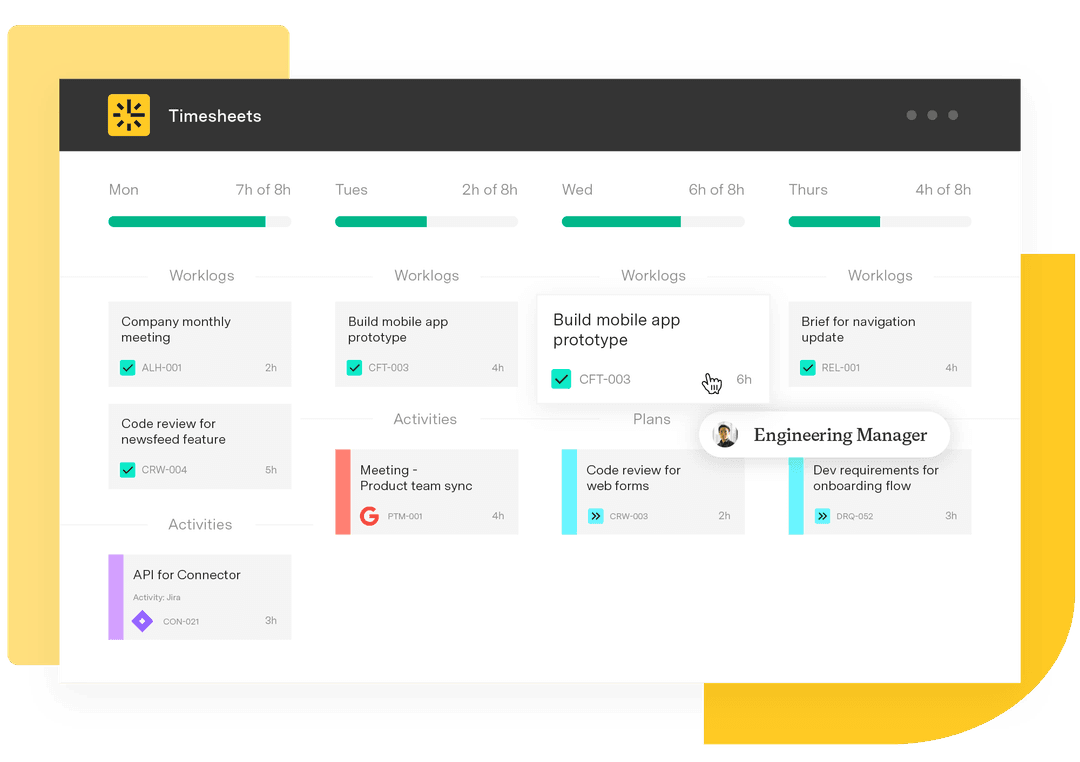Best agile practices and methodology
Tempo Team
Agile project management methodologies can be the difference between projects that adapt and succeed and those that collapse under rigid planning. Though originally designed for software development, agile practices have since proven effective across industries – including marketing, finance, and construction – where flexibility and iterative progress drive success. They allow teams to stay responsive in unpredictable environments, leading to faster, better results.
But what does agile look like in action? Here, we’ll explain agile methodologies, best practices, and benefits to help you understand how the approach enhances project outcomes.
What is agile methodology?
Agile methodology emphasizes adaptability and collaboration, enabling project teams to respond to changing requirements and deliver results in short cycles. Instead of adhering to a rigid, predeveloped plan, agile focuses on continuous progress and teamwork.
At the core of the method is the Agile Manifesto, a set of guiding principles established in 2001 by software developers seeking a more effective way to build products. The manifesto emphasizes four values:
Individuals and interactions over processes and tools
Working software over comprehensive documentation
Customer collaboration over contract negotiation
Responding to change over following a plan
Agile isn’t a single methodology but a collection of frameworks that apply these principles in different ways, depending on the team’s and project’s needs.
What are the most common agile frameworks?
The most widely used agile frameworks include Scrum, Kanban, lean, extreme programming (XP), and feature-driven development (FDD). Here’s an overview of each:
Scrum
Scrum organizes work into fixed-length iterations, called sprints, which typically last two to four weeks. The framework assigns specific roles to team members:
The product owner defines priorities.
The Scrum Master facilitates the process.
The development team executes the work.
Scrum encourages continuous improvement through sprint reviews (where the team reflects on progress) and retrospectives (which identify improvements for the next sprint). It also includes daily stand-up meetings – brief check-ins where team members share progress and ideas. Although Scrum is primarily used in software development, it’s also effective in other industries that require iterative project management.
Kanban
Kanban is a visual workflow management system that optimizes efficiency by limiting the number of concurrent tasks. Project teams maintain a Kanban board, where tasks move across columns representing different stages of completion.
The Kanban system reduces bottlenecks by making work visible, allowing teams to adjust priorities. It’s particularly useful for teams with ongoing work, such as IT support or content production, where tasks vary in scope and urgency.
Lean
Lean applies lean manufacturing principles to the agile development process and project management, focusing on minimizing waste and improving efficiency. It eliminates unnecessary steps and prioritizes value-added activities. Key practices include small batch sizes (breaking work into smaller chunks to reduce cycle time) and continuous customer feedback (verifying products meet user needs).
Lean helps teams streamline workflows while staying flexible, making it ideal for environments that require quick adjustments.
Extreme programming (XP)
XP prioritizes technical excellence and frequent product releases. It includes practices such as:
Test-driven development
Pair programming
Continuous integration
Coding standards
XP is particularly effective in environments where requirements change frequently, as it encourages high-quality code and enables rapid adaptability.
Feature-driven development (FDD)
FDD is an agile approach that organizes work to build specific functionalities in short, structured phases. The process begins with creating a system model and then implementing features in small increments. FDD works well for large-scale projects that require documentation and development while maintaining the flexibility of agile.
What are the pillars of agile?
As noted earlier, the Agile Manifesto is based on four pillars that define the agile mindset and guide teams in delivering high-quality results.
Individuals and interactions over processes and tools
Agile values the people doing the work and their ability to communicate effectively over reliance on rigid processes or tools. Although tools and agile processes improve efficiency, they shouldn’t replace collaboration. Agile teams work best when members openly discuss challenges and adjust to new information, rather than strictly adhering to predetermined procedures.
Working software over detailed documentation
Instead of focusing on extensive documentation before development begins, agile project management emphasizes creating functional, testable outputs. This approach doesn’t eliminate documentation but ensures it supports development without slowing it down. The goal is to deliver a working product quickly, then refine it over time based on feedback.
Customer collaboration over contract negotiation
Agile encourages ongoing engagement with stakeholders, rather than relying on predefined agreements. Teams work with customers throughout the project to develop a final product that meets their evolving needs.
Responding to change over following a plan
Traditional project management assumes the initial plan will remain the same throughout the project. In contrast, agile project management acknowledges that requirements evolve and encourages teams to adapt. Change isn’t seen as a setback but as an opportunity to improve results. Agile teams continuously reassess priorities and adjust their approach to deliver the best outcome.
Agile best practices
Agile project management succeeds when teams apply structured yet flexible practices that promote efficiency and adaptability. These best practices ensure transparent progress and continuous improvement:
Sprint planning and iterative development
Planning is the foundation of agile execution, helping teams adapt to change and maintain consistent progress. Before each sprint, teams define achievable goals by breaking down large tasks into small, manageable units they can complete within the sprint.
Iterative development means delivering work incrementally rather than all at once. Teams complete functional portions of the project with each sprint rather than aiming for a finished product months later. Iteration allows for frequent testing and continuous refinement based on real-world use.
Daily stand-ups and continuous feedback
Daily stand-up meetings, or Scrums, provide quick status updates from each team member. They should answer three questions:
What did I accomplish yesterday?
What am I working on today?
Are there any blockers?
These short meetings identify potential roadblocks early, ensuring smoother progress.
Continuous feedback is also essential to agile project management. Instead of waiting until the end of a project for evaluation, teams gather input from stakeholders, users, and team members throughout development to address changes as needed.
Prioritized backlogs and user stories
A backlog is a list of evolving tasks and fixes the team must address. Product owners and teams collaborate to prioritize and tackle the most important tasks first.
User stories are a core agile tool that defines work in terms of customer needs. They follow this format: "As a [user type], I want [feature] so that [benefit]." User stories keep development customer-focused, ensuring every feature adds value to the product.
Agile teams combine sprint planning, continuous feedback, and prioritized backlogs to maintain momentum.
Benefits of agile practices
Agile practices enable teams to work more efficiently, adapt quickly to changes, and deliver value to users. Here’s how they contribute to better outcomes across teams and projects.
Faster delivery and adaptability
Agile’s iterative approach helps teams produce working solutions in short cycles. Iteration enables early releases and the flexibility to make adjustments based on user feedback.
Increased transparency and accountability
Agile frameworks promote clear communication through sprint planning, daily stand-ups, and frequent check-ins. Team members understand their responsibilities, and stakeholders can track progress at every stage.
Higher product quality
Continuous testing and feedback loops catch issues early, reducing costly fixes later. Agile teams focus on refining their work throughout development, rather than waiting until the end.
Better alignment with customer needs
Ongoing collaboration with stakeholders ensures agile teams build products based on actual user feedback, not assumptions. This results in higher customer satisfaction and more relevant solutions.
Improved team collaboration and morale
Agile fosters a culture of open communication and shared ownership. Self-organizing teams have more control over their workflows, leading to higher engagement and motivation.
Tools to take your agile team to the next level
The right agile technology enables teams to streamline workflows and track time, ensuring alignment and continuous progress. Tempo offers a range of solutions to support these efforts:
Time tracking: Timesheets is a time-tracking and resource management tool that integrates with Jira. It helps teams monitor work hours, analyze productivity, and allocate resources.
Project visualization: Structure PPM enables teams to visualize projects hierarchically, making it easier to organize tasks and track progress. This tool breaks down complex initiatives into manageable tasks, providing a clear view of the work ahead.
Roadmapping: Strategic Roadmaps give teams a comprehensive view of project goals and timelines, allowing for iterative planning while staying aligned with long-term objectives. The platform helps teams map out milestones and dependencies so they can adapt their approach as priorities shift.
Together, Tempo’s tools support better decision-making and improve resource allocation. By integrating them into agile workflows, teams maintain structure without sacrificing the flexibility needed to adapt to changing demands. Book a demo today.














































